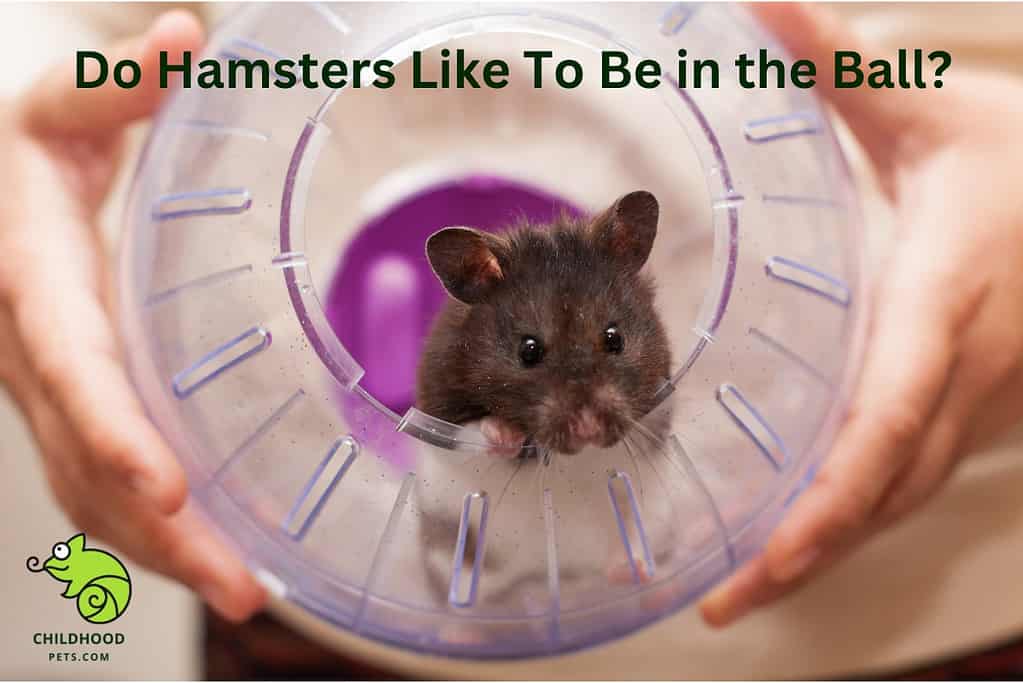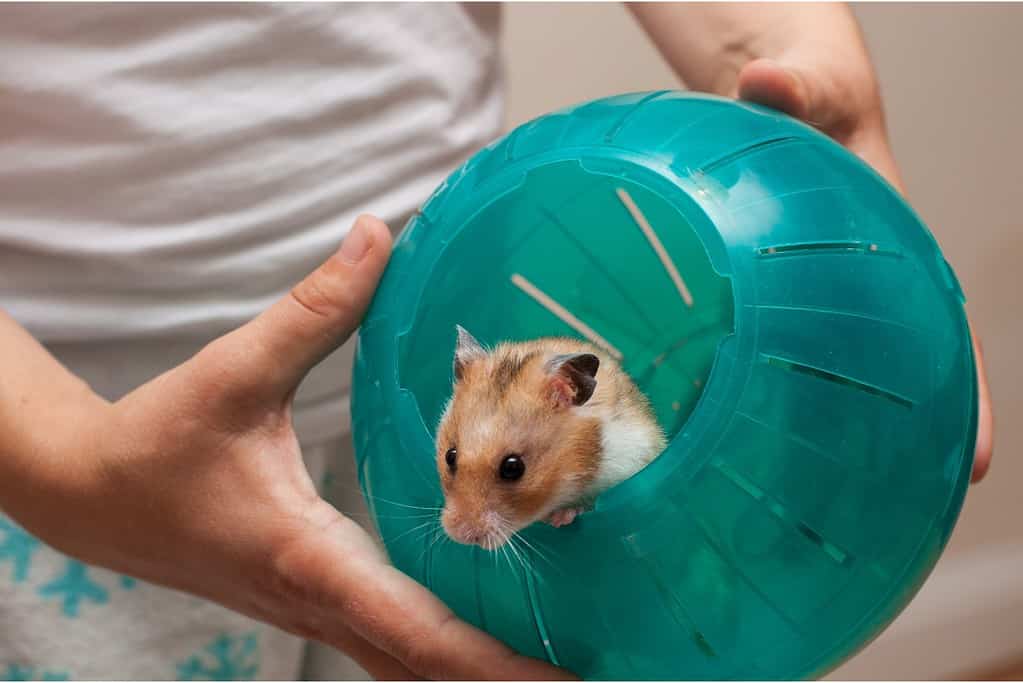
Hamsters are notoriously active and playful animals that love to explore their surroundings. Despite their size, hamsters are energetic and can be pretty lively! Playing is an essential part of a hamster’s life and helps keep them from being bored or stressed out. But do hamsters like to be in the ball?
As a whole, hamsters enjoy being in the ball. They enjoy running around in their balls, a plastic balls with air holes that allow them to explore their surroundings without escaping. They get physical exercise and mental stimulation from exploring their surroundings safely and securely.
This article will cover the pros and cons of using a hamster ball as an exercise and a toy. We will discuss risks and precautions to ensure hamsters’ safety. So let’s get started!
Is It Safe for the Hamster To Be in the Ball?
Yes, it is safe for a hamster to play in an exercise ball if a few safety guidelines are followed.
- The ball should be the appropriate size for your hamster. A ball that is too large may allow them to escape or cause the animal discomfort while attempting to move inside.
- Providing a safe surface for the hamster to play on is essential. Never use the ball on carpets or rugs, as these surfaces can cause your pet to become stuck and put them at risk of serious injury. Also, choose a high-quality exercise ball with ample ventilation for your hamster.
- It’s essential to supervise your pet while in the ball and watch out for any signs of stress, such as excessive panting or restlessness. If your hamster becomes tired, gently remove them from the ball and provide a safe and comfortable place to relax.
Following these guidelines will ensure that your pet enjoys their playtime in the safety of an exercise ball.
Do Hamsters Like To Be in the Ball? Pros and Cons of a Hamster Exercise Ball
Hamsters enjoy the freedom of movement that an exercise ball provides. It can be a great way to give them some extra physical and mental stimulation in their environment. However, owners should know some drawbacks along with the benefits of using a hamster exercise ball.
Pros:
- Exercise balls give your hamster ample space to explore and exercise, even in a small area.
- It’s an entertaining way for your hamster to stay active.
- Hamsters love the physical and mental stimulation of exploring their environment.
- Allows the hamster to explore its environment safely, as it can’t escape.
- It provides the hamster with physical activity and mental stimulation, which may help reduce boredom and improve overall health.
Cons:
- If not monitored closely, hamsters can escape from exercise balls or become stuck.
- Long-term use of an exercise ball can lead to boredom, as hamsters crave variety in their environment.
- Hamsters can get stuck inside the ball if it doesn’t have adequate ventilation.
- Your hamster could suffer from exhaustion or heat stroke if used too often.
- Hamsters can experience fear and stress if exposed to too much noise or movement.
Exercise balls can be a great way to give your hamster extra physical and mental stimulation. However, monitoring your hamster’s health and using the ball in moderation is essential to avoid potential harm.
Are Hamsters Naturally Inclined To Run in a Ball?

No, hamsters are not naturally inclined to run in a ball. This is a behavior that their owners have taught over time. It takes time and patience for them to learn how to navigate the ball and enjoy the activity. Some hamsters may never feel comfortable enough with it to prefer running in a ball, while others may take to it quite quickly. It all depends on the individual hamster and its temperament.
Hamsters typically prefer exploring their environment on foot rather than inside a ball. It is important to note that although hamsters can run in a ball, it is not recommended as a regular activity because it can place unnecessary stress on their bodies.
What Kind of Exercise Does a Hamster Get From Being in the Ball?
Hamsters get a great deal of exercise from running in the ball. Because hamsters are naturally curious and adventurous, they enjoy exploring their environment while running in the ball. Running around in the ball also helps to stimulate their mind as they take in all the sights and sounds of their surroundings.
Additionally, because it is an enclosed space and hamsters cannot jump out, the ball offers an excellent way to explore their environment without risking escaping safely. As they roll around in the ball, hamsters actively work their muscles and get a great cardiovascular workout. This helps to keep your little furry friend healthy and happy!
How Much Time Should a Hamster Spend in Their Ball Each Day?

Hamsters should not spend more than 20-30 minutes daily in their ball. Some may enjoy longer sessions, while others fatigue quickly and need shorter bursts of exercise. Monitor your pet’s energy levels and adjust the time accordingly to ensure it does not get too tired or stressed out.
Prolonged use of the wheel can be damaging to its feet, so keep an eye on it and limit its running time. Over-exercising can lead to exhaustion, preventing it from exploring its environment or engaging in other activities. Monitor your hamster’s energy levels regularly and adjust their exercise schedule accordingly for a healthy and balanced lifestyle.
Can the Use of a Hamster Ball Cause Stress to the Hamster?
Yes, a hamster ball can cause stress to your pet. Being confined in the small space of a hamster ball for too long can cause your hamster to become stressed and anxious. Additionally, constantly moving can be tiring for your hamster and may lead to stress-related health problems if they do not get adequate rest. It’s essential to allow your hamster to explore its environment safely rather than relying purely on its hamster ball for exercise.
If you decide to use a hamster ball as part of your pet’s routine, limiting the amount of time spent in it each day is best to ensure they have access to a comfortable area to rest and relax. Plenty of enrichment and stimulation within the cage will also help keep your hamster happy and reduce stress.
Are There Any Precautions To Consider When Using a Hamster Ball?
Yes, there are a few precautions to take when using a hamster ball:
- Make sure your hamster is the right size for the ball. The ball should be large enough for your hamster to turn around but not so large that it can become lodged in corners or crevices and get stuck.
- Ensure the ball is well-ventilated with plenty of holes and openings to ensure your hamster can breathe adequately when inside.
- Supervise your hamster at all times while they are in the ball, as there may be dangers lurking around the house that could harm them if left unattended.
- Don’t leave the ball on slippery surfaces like hardwood floors, as your hamster may not be able to remain stable while inside and could fall out or tip over.
- Clean the ball regularly with warm water and mild soap to prevent the build-up of bacteria or other contaminants.
Following these precautions can help ensure your hamster’s safety and allow them to have fun in the ball!
Final Thoughts
Hamsters love exploring in their balls! Supervised activity is key to providing them with a safe and stimulating environment. Ensure the ball is big enough for your hamster so they don’t feel cramped; this will grant them freedom and encourage exploration. Regular breaks, variety, and supervision make the perfect combination for an active and entertained pet. Enjoy the journey!
Now it’s your turn to share. Have you ever used a hamster ball with your pet? What tips would you add for using a hamster ball safely and responsibly? Let us know in the comments section below!
Frequently Asked Questions
Do hamster balls have holes?
Yes, hamster balls usually have holes so your pet can breathe while in the ball and not overheat. Make sure these openings are not clogged or blocked to ensure adequate ventilation.
Do hamsters sleep in a ball?
Hammies sleep curled up and very well hidden in their little nest. Seeing the hamster will take work. But you can sometimes see parts of the nest moving when he twitches or shifts.
Why do hamsters curl in a ball?
A hamster in a deep state of inactivity will be limp and unresponsive to both touch and sound. You may find them curled up into a ball as they try to keep warm.
